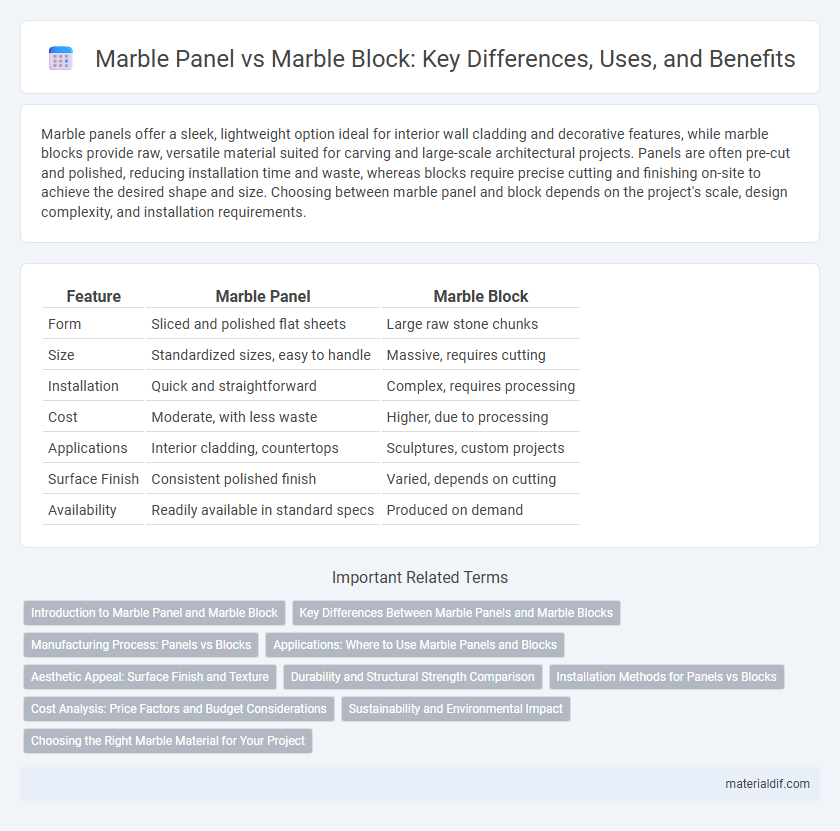Marble panels offer a sleek, lightweight option ideal for interior wall cladding and decorative features, while marble blocks provide raw, versatile material suited for carving and large-scale architectural projects. Panels are often pre-cut and polished, reducing installation time and waste, whereas blocks require precise cutting and finishing on-site to achieve the desired shape and size. Choosing between marble panel and block depends on the project's scale, design complexity, and installation requirements.
Table of Comparison
| Feature | Marble Panel | Marble Block |
|---|---|---|
| Form | Sliced and polished flat sheets | Large raw stone chunks |
| Size | Standardized sizes, easy to handle | Massive, requires cutting |
| Installation | Quick and straightforward | Complex, requires processing |
| Cost | Moderate, with less waste | Higher, due to processing |
| Applications | Interior cladding, countertops | Sculptures, custom projects |
| Surface Finish | Consistent polished finish | Varied, depends on cutting |
| Availability | Readily available in standard specs | Produced on demand |
Introduction to Marble Panel and Marble Block
Marble panels are thin, precisely cut slabs often used for wall cladding, flooring, and decorative surfaces, providing a lightweight and easier-to-install option compared to marble blocks. Marble blocks are large, solid chunks of raw marble extracted from quarries, ideal for structural applications and custom sculpting due to their substantial size and versatility. Understanding the difference between marble panel and marble block is crucial in selecting the appropriate form for construction, design, or artistic projects.
Key Differences Between Marble Panels and Marble Blocks
Marble panels are thin, prefabricated sheets typically measuring 2-3 centimeters in thickness, offering ease of installation and uniformity for interior applications such as walls and countertops, whereas marble blocks are large, raw stone masses extracted from quarries, requiring cutting and shaping for customized architectural or sculptural uses. The dimensional precision and surface finish of marble panels facilitate faster project completion, while marble blocks provide greater versatility for bespoke designs and structural elements. Understanding these distinctions is crucial for selecting the appropriate material based on project scale, budget, and aesthetic requirements.
Manufacturing Process: Panels vs Blocks
Marble panels undergo a manufacturing process that involves slicing large marble blocks into thin, uniform sheets using diamond-wire saws, ensuring consistent thickness and smooth surfaces suitable for architectural cladding and interior applications. In contrast, marble blocks are extracted as massive raw slabs directly from quarries with minimal processing, primarily used in sculpting, large structural elements, or customized fabrication. The panel production emphasizes precision slicing and finishing, while blocks require more extensive machining and shaping to meet specific design requirements.
Applications: Where to Use Marble Panels and Blocks
Marble panels are ideal for interior applications such as wall cladding, countertops, and decorative veneers due to their precision-cut surface and ease of installation. Marble blocks are primarily used in large-scale projects like sculptures, monuments, and architectural columns where substantial material is required for carving and structural integrity. Selecting marble panels or blocks depends on the project's scale, design complexity, and installation environment, ensuring optimal use of material properties for aesthetic and functional purposes.
Aesthetic Appeal: Surface Finish and Texture
Marble panels offer a smooth, polished surface with consistent texture ideal for sleek, modern interiors, while marble blocks provide natural veining and irregularities highlighting raw, organic beauty. The surface finish of marble panels is often refined through industrial processing, ensuring uniformity in color and shine. In contrast, marble blocks emphasize unique patterns and textures, appealing to designs that value natural aesthetics and individuality.
Durability and Structural Strength Comparison
Marble panels exhibit enhanced durability due to their engineered composition, offering consistent strength suitable for modern architectural applications. In contrast, marble blocks provide superior structural integrity and natural robustness, making them ideal for heavy-duty construction and sculptural projects. Evaluating project requirements for load-bearing capacity and longevity helps determine the optimal choice between marble panels and blocks.
Installation Methods for Panels vs Blocks
Marble panels are prefabricated and lightweight, enabling faster installation with adhesive bonding or mechanical fasteners on walls or floors, whereas marble blocks require heavy machinery for cutting, lifting, and precise placement due to their substantial weight and size. Panels often use interlocking systems and backing materials to improve stability and ease of handling, while blocks demand skilled labor for on-site shaping and anchoring to ensure alignment and safety. Installation of marble blocks typically involves more extended downtime and higher costs compared to the streamlined process associated with marble panels.
Cost Analysis: Price Factors and Budget Considerations
Marble panel costs generally depend on fabrication expenses, thickness, and finishing techniques, making them more budget-friendly for interior applications compared to marble blocks. Marble blocks involve higher expenses due to extraction, transportation, and processing, significantly impacting overall project budgets. Evaluating price factors like material yield, installation complexity, and waste management is essential for accurate cost analysis in marble selection.
Sustainability and Environmental Impact
Marble panels offer a more sustainable option compared to marble blocks due to their efficient use of raw material, reducing quarry waste by up to 40%. The fabrication of marble panels involves less energy consumption and lowers carbon emissions, contributing to a smaller environmental footprint. Additionally, panels facilitate easier transportation and installation, minimizing fuel use and further enhancing their eco-friendly profile.
Choosing the Right Marble Material for Your Project
Marble panels offer pre-cut, polished surfaces ideal for quick installation in interior design projects, providing uniformity and reducing labor costs. Marble blocks, raw and unprocessed, allow for custom cutting and carving, making them suitable for bespoke architectural elements and sculptures. Selecting between marble panels and blocks depends on project scope, budget, and desired finish precision, with panels favored for efficiency and blocks chosen for versatility.
Marble Panel vs Marble Block Infographic

 materialdif.com
materialdif.com